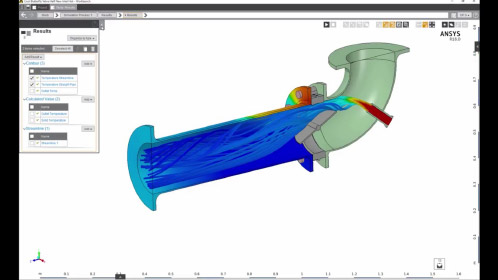Accurate Physics Analyses for Designers

ANSYS AIM is designed to make powerful simulations easy for designers and other engineers with little or experience running analysis jobs. This screen capture from the “ANSYS in Action: ANSYS AIM” video demo shows how design engineers can obtain and explore multiple physics results through the ANSYS AIM interface. Image courtesy of ANYS Inc.
Latest News
June 13, 2017
Dear DE Reader:
Educationalist Ken Robinson once said that “the role of a creative leader is not to have all the ideas. It’s to create a culture where everyone can have ideas and feel that they’re valued.” For engineering, I’d add “by letting them explore their ideas.” Today’s Check it Out link hits a landing page with video details on what sounds like a good idea for making design workflows more creative.
The page focuses on ANSYS AIM, an upfront simulation platform that leverages high-end ANSYS technologies. The company says that it’s low cost. AIM is engineered so that designers and others without analysis expertise can use it for both simple and complex analyses throughout various stages of the design process.
 ANSYS AIM is designed to make powerful simulations easy for designers and other engineers with little or experience running analysis jobs. This screen capture from the “ANSYS in Action: ANSYS AIM” video demo shows how design engineers can obtain and explore multiple physics results through the ANSYS AIM interface. Image courtesy of ANSYS Inc.
ANSYS AIM is designed to make powerful simulations easy for designers and other engineers with little or experience running analysis jobs. This screen capture from the “ANSYS in Action: ANSYS AIM” video demo shows how design engineers can obtain and explore multiple physics results through the ANSYS AIM interface. Image courtesy of ANSYS Inc.That means things like a single interface with guided workflows and capabilities for multiple physics analyses, including fluids, structures, thermal, electromagnetics and polymer extrusion. You can combine multiple physics types to run multiphysics simulations, or simulate one physics type at a time. AIM has integrated modeling for creating 3D concept models or editing/repairing imported geometry. AIM is CAD agnostic, so you can open and edit major 3D CAD formats. AIM handles meshes and many tedious jobs and details automatically, prompting you for input where needed.
Once you arrive at the “ANSYS in Action: ANSYS AIM” landing page, a three-minute video pops up. Watch it for a fast and thorough highlight reel of what’s in AIM for you.
Then hit the Request button on the lower left. Sign up for the “ANSYS in Action: ANSYS AIM” on-demand webinar. It’s a 20-minute demo. Go into full screen mode so that you can see AIM’s uncluttered interface as well as how it unobtrusively and with minimal user input guides you through first a fluid analysis and then a fluid-structure analysis.
The demo covers everything from set-up to meshing to results. Meshing is interesting. AIM adapts mesh types for different areas of the design like bolts and input values. The presenter at one point changes some parameters, and AIM alerts him to change others in response. Watch the mesh progress display on the bottom right. AIM’s meshing appears fast.
This is interesting stuff. If you want to compress design cycles and create an environment where design and analysis teams can better explore ideas, the “ANSYS in Action: ANSYS AIM” landing page is well worth the 30 minutes to watch it all. Hit today’s Check it Out link and see for yourself.
Thanks, Pal. – Lockwood
Anthony J. Lockwood
Editor at Large, DE
Subscribe to our FREE magazine, FREE email newsletters or both!
Latest News
About the Author
Anthony J. Lockwood is Digital Engineering’s founding editor. He is now retired. Contact him via [email protected].
Follow DE





